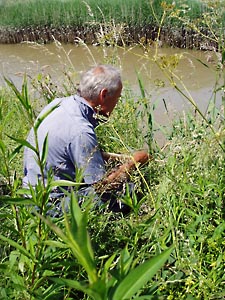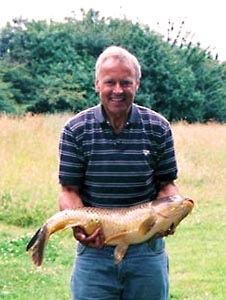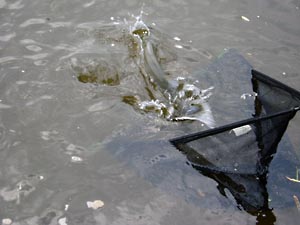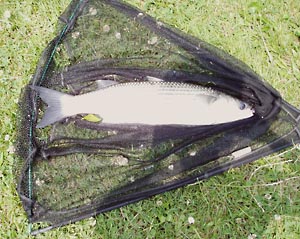|
A few weeks ago I described a memorable day's
fishing on the River Dart in atrocious conditions; it was cold, windy,
and with cascading rain, but quite astonishingly eleven Mullet, five
of which were over specimen were caught, including one of 6lb. 4oz.
The nearby River Teign also offers excellent Mullet
fishing, but contrasts greatly in character. Whereas the Dart is
relatively deep throughout its length, the Teign is broad and shallow,
moving into winding, muddy channels and streams in its upper reaches.
This is what happened on a recent session, when I
fished there as a change from my usual venues.....
The tide was gurgling and foaming through the
estuary mouth, white flecks lacing the greeny depths, as the current
waved against the clumped patches of bladder wrack. The plaintive
cries of a group of Oyster Catchers pierced the empty spaces, as they
flashed their black and white patterned wings, between the rounded
patchwork of fields and water, on their way to the feeding grounds.
Higher up the estuary, imperceptible changes were
taking place. The water gently lapped at the bases of the dense
stands of sedges and tangled undergrowth, slowly creeping up the stems
and covering the muddy stones. Occasional lazy swirls and dimples
marked the passage of fish, fins cutting the water with fast widening
"V" shapes.
Normally the water here was transparently clear,
but following days of thundery rain, the visibility was almost nil,
the colour of ox-tail soup in fact.
At least this sorted out one problem! If I
couldn't see into the water the fish most certainly couldn't see me.
I still needed a stealthy approach, and to keep movement to the
minimum, but for once I didn't need to hide in a tangle of
undergrowth.
 |
Mike Bailey stalks
his quarry
on the upper reaches of the River Teign
June 2005
Photo courtesy
of Mike Bailey |
I set up quickly, putting in some heavy balls of
bread ground bait exactly where I was going to fish. I had chosen a
spot on a bend of the river where there was a natural eddy, meaning
that I could fish hard over this area. Other anglers are often
surprised to see how close to the bank I fish. Here I was fishing
only 2 to 3 feet from the bank.
In such coloured water I could have elected to fish
with a quiver tip and a ledger, but if possible I prefer float
fishing. The water at half-tide was only a few feet deep, but was
rising rapidly with the flood tide.
A generous piece of very soft bread paste was
wrapped around a number 8 hook and I dropped it into the swim. Every
few minutes I brought the bait out to inspect it, and a small handful of
ground bait accompanied it back into the same spot. The float had to
be adjusted as the tide continued to rise, but all was still and
peaceful, without the sign of a bite registering on my float.
Three hours passed with only the continuous sound
of nesting Warblers in the banks of sedges, and Skylarks high in the
sky. The iridescent flash of a Kingfisher darting swiftly upstream
and the shimmering Dragon Flies around my float were a welcome sight,
but the float remained obstinately unmoving.
High tide was approaching and I was now fishing in
water that was fully six feet deep, when the float flickered,
half-bobbed, then sat still again. Lifting it out, the hook was bare,
but it was a bite! A few minutes later, the float moved sideways; a
fish had hit the line as it swam past. The tension was mounting.
Sure enough, seconds later the float slid smoothly away. A firm
strike but the fish had gone!!!
Another missed bite. With shaking hands I quickly
re-baited. I hardly dropped the bait in the water and the float
bobbed then gently sank from sight. This time the strike saw the
clutch screaming line off, as a very big fish steamed off towards
Teignmouth.
As it tore off downstream I used my finger to exert
increasing pressure on the clutch in an effort to stop the first run.
The rod was 'hooped' into its full test curve and I was putting the
maximum side-strain on the fish to try to turn it in its headlong
dash. Still it kept going with over 50 yards of line taken, and
the power was immense. Far out in the distance there was a huge
swirl in the water and a momentary glimpse of a great tail in the murk, then
it disappeared.
For the next ten minutes battle was well and truly
joined. Something down there was sulking near the bottom and every
so often trundling off in ponderous and unstoppable runs.
I've had lots of big Mullet on light lines so all I
could do was be patient and wait for the fish to tire. Eventually,
after some 20 minutes there were signs that the fish was beaten; the
runs became shorter, and each time I gained a few precious yards back
onto the reel.The water was so thick that
it was impossible to see what I was hooked into until it was almost
below the rod top.
Suddenly, there was a huge swirl and a great
golden slab appeared as the fish rolled on its side. The mystery fish
was revealed as a CARP, and a good one too, well into double figures.
A fine Common Carp
caught
in the brackish water of the
River Teign by Mike Bailey
of Brixham SAC
June 2005
Photo courtesy
of Mike Bailey |
 |
The fish was played out and wallowing about.
Slipping the net underneath, there it was. A beautiful yellowy gold
Common Carp, long and lean and in perfect condition. What a catch!
No scales I had could weigh such a fish, so after a quick photograph,
it was gently returned , lazily disappearing back into the depths with
a contemptuous flick of its great paddle-shaped tail.
 |
Mike Bailey proudly
holds
his Common Carp caught
in the brackish water of the
River Teign
June 2005
Photo courtesy
of Mike Bailey |
Anything after that was going to be an
anti-climax, but as the tide slowly ebbed away I continued to fish.
Patience has its its own reward and some two hours later a few
tentative bites developed. They had to be Mullet; sure enough, the
float dipped, and I hooked a heavy fish. This one tore off line and
shook it head violently all the time. Some time later, a beautiful
fish, just on specimen weight, came to the net.
A fine Grey Mullet
is brought to the
landing net by
Mike Bailey
June 2005
Photo courtesy
of Mike Bailey |
 |
The water was fast disappearing and the bites had dried up, so it was
time to go. Another memorable days fishing.
Every session of fishing is so unpredictable and no
two days are the same. That's what makes it such a great pass-time.
 |
Grey Mullet on
Landing Net
just before being returned
alive and in peak condition
to fight again another day
June 2005
Photo courtesy
of Mike Bailey |
The capture of the carp set me thinking; the area
I caught it in was strongly tidal and there have been reports of Carp
taken much further down the river towards the sea. It would be
interesting to know how tolerant of brackish/salt water these fish
are.Perhaps there is a marine biologist
somewhere who could shed light on this matter?
|

